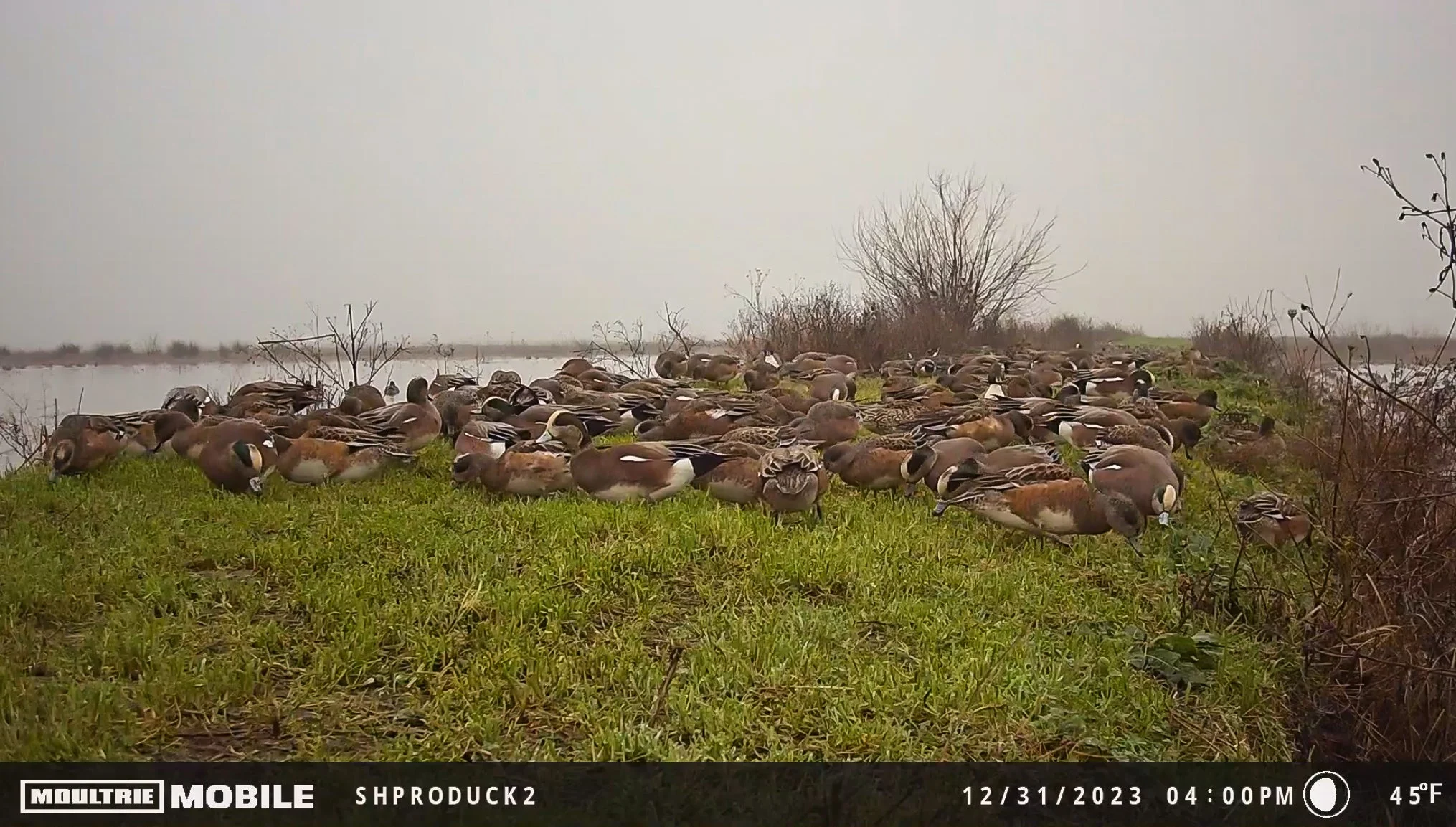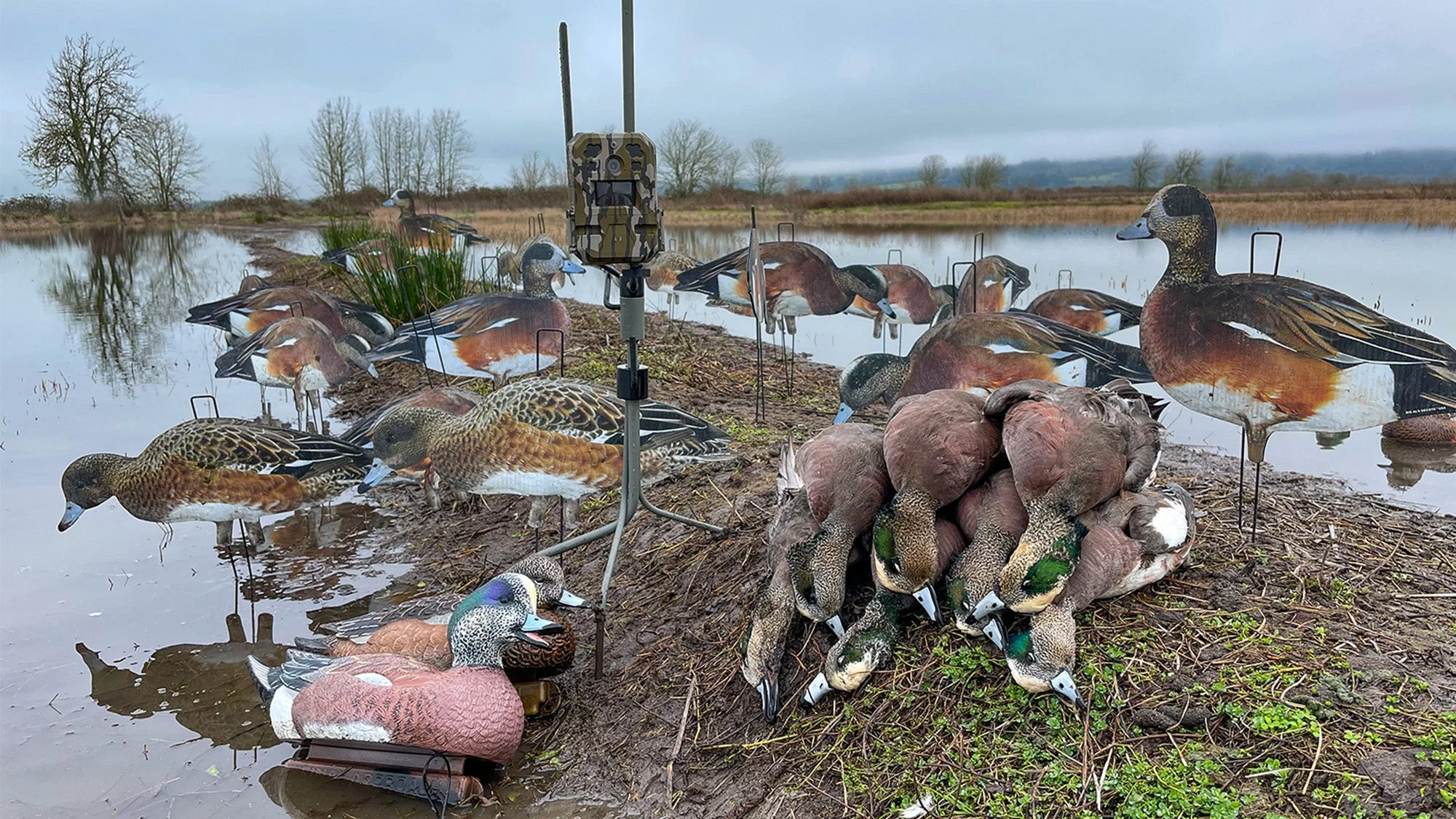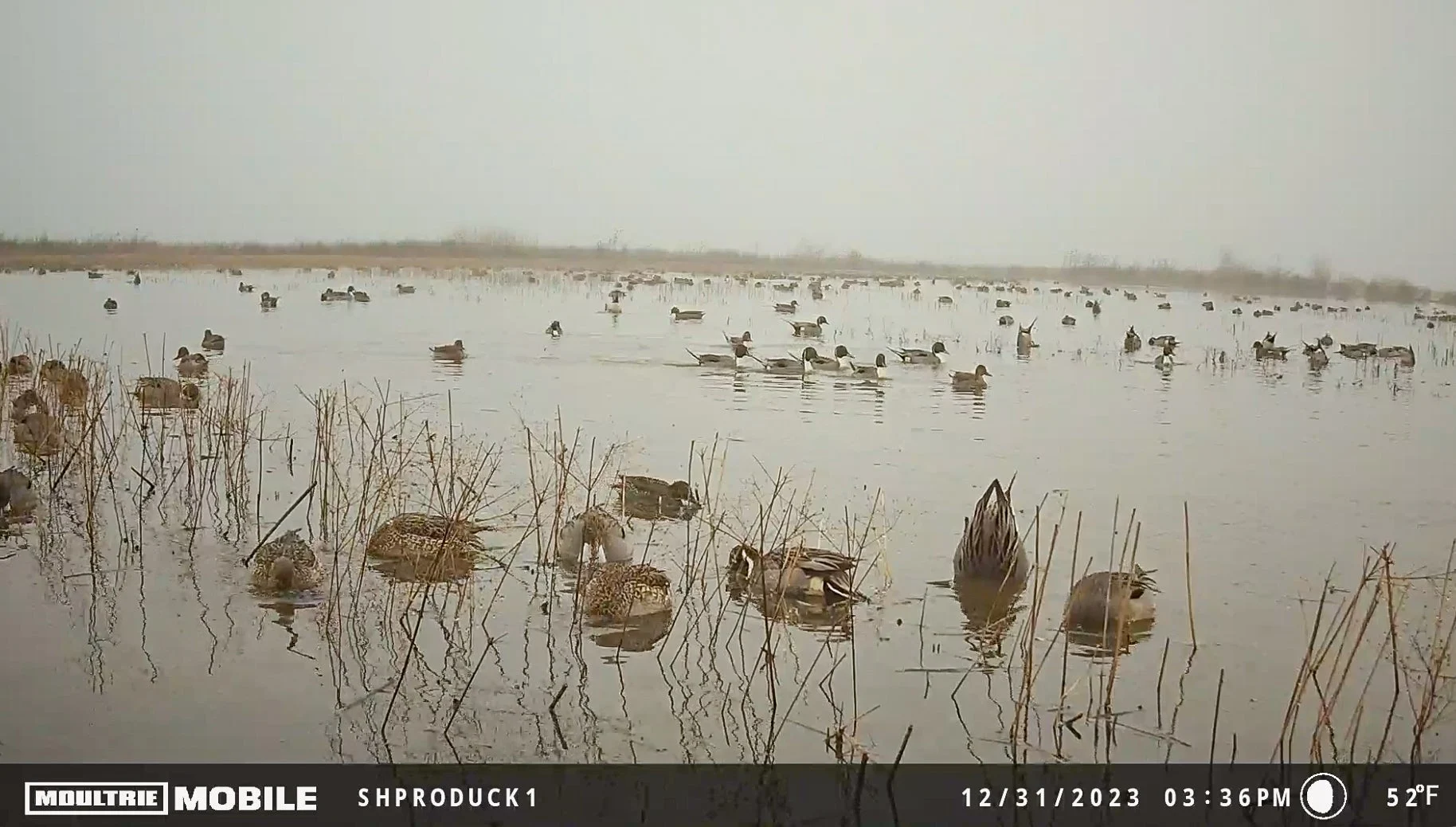It was 4:30 a.m. when I texted my hunting buddy that we were switching to plan B. I’d just received a notification on my phone from the Moultrie Mobile app. It revealed big groups of wigeon had moved in to feed on green grass near the edge of a pond. I put the Edge Pro trail cam there four days prior and it paid off. We shot our limit in under 30 minutes.
Four years ago, I started running non-cellular trail cams for ducks. And while it was helpful for understanding duck behavior and migration patterns, I was always one step behind the birds. Last season, I switched to using Moultrie Mobile cellular cameras, and everything changed. Now, I get real-time updates when ducks move into any of my spots. But don’t be fooled: Setting trail cams for ducks isn’t as easy as getting a notification on your phone and then walking out back to shoot them. It takes preparation, scouting, discipline, and, most importantly, the ability to be mobile.
Last year, during my 100-plus-day Pacific Flyway duck season, I learned a few things about running trail cams for waterfowl. Some tactics are based on traditional duck scouting techniques, and others go hand in hand with running trail cameras for other species. Either way, each technique led to successful hunts and heavier straps. So get a cellular trail camera and use these ten tactics to kill more birds next season.

Large flocks of wigeon captured on the author’s trail cam the day before shooting an all-drake 7-bird limit. Scott Haugen
1. Run Cellular Cameras Over Traditional SD Cams
Checking traditional SD trail cameras is time-consuming, and if you aren’t pulling cards every day during duck season, you might miss a push of birds. Cell cams remove the need to check your camera every day. They relay information instantaneously. Set the notifications on your smartphone, and you’ll receive up-to-the-minute action as it unfolds with the cellular models. This is especially helpful during peak migration, when big flocks of birds migrate through an area quickly. Sometimes, ducks only stop for a day or two to refuel before continuing south. Where legal, a reliable cell cam, like the Edge Pro, will notify you when the birds are in so you can hunt them before they’re gone.
2. The More Cameras the Better
Come waterfowl season, I set at least two dozen cams to monitor the movement of ducks and geese. Most hunters don’t need to run that many, but the idea is simple: The more cameras you have out, the more area you cover to find birds. I’ll increase the number of cams I have set depending on water levels, time of season, and migration peaks. The later in the season it gets, the more cameras I use. I’ll set them on private and public land, rivers, creeks, sloughs, ponds, and fields. Anywhere you can get a camera out will help you better pattern birds.
3. Use a 4×4 Fence Post to Anchor Your Cameras
The easiest and most secure way to set a trail cam for ducks is by attaching it to a 4×4 wooden fence post. I screw in a Moultrie Mobile Edge Series Flex Mount into the post, drive it into the ground, and attach the camera. This mount is secure and can be moved for precise positioning. Be sure to screw the post into a spike so if the water rises, it won’t float away. If you are setting cameras in areas where water levels may rise—like in creeks, riverbanks, and ponds—use a longer wooden fence post to keep the camera dry. Also, make sure the post is anchored well enough that winds and currents won’t carry it away.

A one-man all-drake wigeon limit next to the author’s Moultrie Mobile Pro Edge trail cam. Scott Haugen
4. Monitor Potential Food Sources All Season
While trail cameras are excellent scouting tools, it’s essential to do some pre-season scouting before setting them. In the off-season, I’m looking to food sources to set my cams on. I’m also noting where different foods are located based on future water levels. Some foods are easily accessible to ducks with little rain. Others don’t become available to birds until late in the season, following a high water event or even a freeze. Certain food sources require flooding to allow ducks access to it. Keep track of agricultural activity near your hunting area, which will also impact duck movement during the season.
5. Use Video Mode
A 15 second video clip captures sights and sounds a still image never will. Every season, I discover high numbers of ducks using an area based on the sound alone. One or two ducks might be swimming in front of the camera, but thousands more can be heard off-camera. Use video mode to get the most information you can from your cams.
6. Let Bird Numbers Build on Loafing Areas
A hundred wigeon grazing on new grass might seem inviting, but nothing attracts birds better to an area than live birds. So if you’re monitoring a long-term food source or roosting sites, let the number of ducks build on your cams before hunting them. For these locations, I usually wait until numbers hit a few thousand to hunt them. That won’t be the case for every area, so wait until you think there are enough birds to get multiple hunts out of it. Once you hit a huntable number, go in early, shoot fast, and exit quickly. Doing so will allow you more hunts in this same spot. If you hunt a spot too soon, before numbers build, you might only get one shoot from it.

The author’s trail cam captured this photo of hundreds of pintail on a flooded marsh. Scott Haugen
7. Immediately Hunt Short-Term Food Sources
On the flip side, short-term food sources should be hunted right away. With these, there’s no need to let bird numbers build for fear the food might be quickly depleted. Short-term food sources are dictated by fluctuating water levels, wind intensity, and bird numbers. A rising creek, a section of a river, or even a flooded field may only offer ducks access to food for a short time. This can last anywhere from a day or two to 12 hours or less. How fast water levels rise and fall determines how long ducks can reach the food.
Identify these areas in the off-season and monitor them daily on your cams. Once the cameras are showing water and ducks, hunt them immediately. High winds and rising water can move food around ponds, congregating it on the leeward side. Set a camera in these spots and hunt it as soon as the first birds arrive. This is also true for skinny creeks that run high and offer ducks access to food they otherwise couldn’t reach. In flooded fields and sloughs that expose food, either by access or by physically knocking food from stalks, get on ‘em. Food that can’t support the arrival of thousands of ducks should be hunted fast before ducks consume it and leave.
8. Keep Your Gear Light
Cellular trail cameras are set to achieve one goal: To hunt the X. For this reason, you can pack light. You’re already where birds want to be, so don’t go overboard. A simple blind (sometimes you don’t even need one) and a handful of decoys will do the trick. A half dozen floaters with a couple dozen silhouettes are also easy to carry in for one trip. I usually set three to five dozen Big Al’s silhouette decoys along shorelines and in shallow water. Small spreads are also easy to pick up and relocate should the X shift for whatever reason. Hunting pressure, wind direction, and storms can cause the X to shift overnight, or even during the course of a hunt. Effectively placing trail cams allows you to stay on the X—and being where the ducks want to be is more important than the number of decoys you set.
9. Mimic What You See on Camera
Match the hatch, or, in other words, keep your spread as realistic as possible. If a trail camera reveals small flocks of ducks slowing moving into an area, set out a small spread. If there’s a mix of species coming in at once, mimic that in your spread. If birds pack closely together while feeding, arrange your decoys the same way. This is one of the biggest advantages of using a trail cam for ducks—you can see exactly how the birds behave. Replicating this will help you finish more ducks over the decoys.
10. Be Mobile
Cellular trail cameras reveal where ducks want to be at that moment. Use your cams to track bird movement daily throughout the season. Don’t hunt an area just because the birds were there the last few days. Use your cams to confirm if spots are holding birds, and then be ready to make adjustments. That means having all the gear you need ready to go at a moment’s notice. As the X shifts, move with it.

